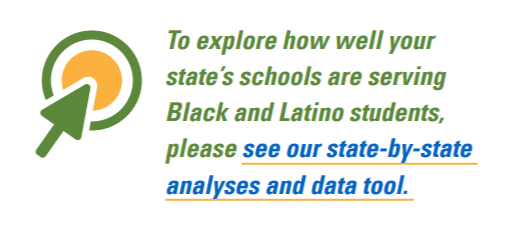Inequities in Advanced Coursework
Black and Latino students across the country experience inequitable access to advanced coursework opportunities. They are locked out of these opportunities early when they are denied access to gifted and talented programs in elementary school, and later in middle and high school, when they are not enrolled in eighth grade algebra and not given the chance to participate in Advanced Placement (AP), International Baccalaureate (IB), and dual enrollment programs. As a result, these students are missing out on critical opportunities that can set them up for success in college and careers.
This is not a new problem. In 2013, as part of our Shattering Expectations series, we looked closely at AP and IB participation rates nationally and by school and found that hundreds of thousands of students of color and students from low-income backgrounds were missing out on these opportunities.
But disparities in access to advanced coursework are not inevitable.
In this brief, we look at ways Black and Latino students are locked out of advanced coursework opportunities, diagnosing the particular types of barriers our school systems put in their way, and offer actionable solutions for state, district, and school leaders.
“Advanced coursework opportunities can place students on the path toward college and career success. Yet, too many Black and Latino students never receive the opportunity to enroll through no fault of their own. No student should forfeit future success because there were not enough seats in the class or because the seats were not available.”
— Kayla Patrick, P-12 data and policy analyst
In some instances, the problem is that Black and Latino students attend a school without any advanced courses; in others, they attend a school that enrolls too few students in advanced coursework overall, or one with inequitable course assignment, meaning Black and Latino students in particular are being denied access to courses. Also, within a particular state, the problems are often different for Black students than Latino students.
In all cases, unearthing these barriers to opportunity will help state leaders pursue targeted solutions that will actually move the needle for both groups of students.
Finding 1
Black and Latino students are successful in advanced courses when given the opportunity.
Finding 2
While it is clear Black and Latino students are often successful in advanced coursework opportunities, they are still not fairly represented in advanced courses.
Finding 3
Nationally, inequities are largely due to (1) schools that serve mostly Black and Latino students not enrolling as many students in advanced classes as schools that serve fewer Black and Latino students; and (2) schools – especially racially diverse schools – denying Black and Latino students access to those courses.
Finding 3a
Courses Offered: Nationally, Black and Latino students are fairly represented among schools that offer advanced courses. But there are still too many schools that don’t offer the courses at all.
Finding 3b
Total Seats: The schools that enroll the most Black and Latino students have slightly fewer students enrolled overall in advanced courses that schools that serve fewer Black and Latino students.
Finding 3c
Share of Seats: Among schools that offer advanced courses, Black and Latino students are often denied access to those courses. This is especially true in racially diverse schools.

“Nationally, what we’ve found is that Black and Latino students can be successful in advanced courses when given the opportunity, but unfortunately, they are not fairly represented in advanced courses. The story gets more complicated when we dig deeper into state-by-state data to understand what is driving those national trends. The barriers to access and success in advanced coursework are different from one state to the next, and within states maybe be different for Black students than for Latino students.”
– Ivy Smith-Morgan, associate director of P-12 analytics
What State Leaders Can Do
- Set clear, measurable goals for advancing access to and success in advanced coursework and commit to publicly measuring state and district progress toward those goals.
- Use data to identify the barriers that prevent students of color and students from low-income backgrounds from enrolling in advanced courses.
- Invest dollars to expand advanced coursework opportunities in schools serving the most Black and Latino students.
- Expand eligibility and increase access so that Black and Latino students have a fair chance to take advanced coursework.
- Provide sufficient support for students to prepare for advanced coursework and for their success once they are enrolled.
